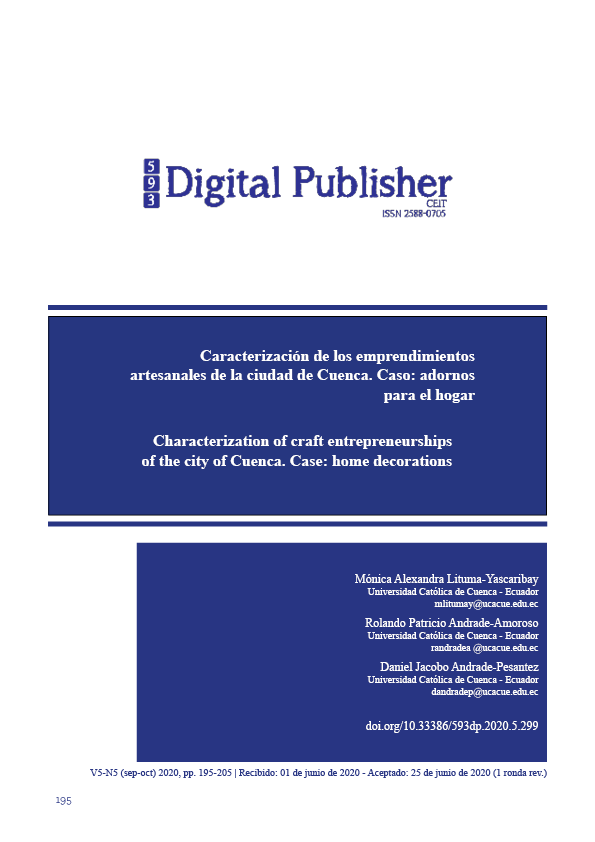Characterization of craft entrepreneurships of the city of Cuenca. Case: home decorations
Main Article Content
Abstract
In Ecuador, the artisanal sector is one of those that contributes the most dynamism to the country's economy, generating employment and economic growth at the local and national level. Among the organizations that support this sector can be identified the National Board of Defense of the Artisan which is an autonomous organism to support and control the artisans whose mission is to strengthen their activities. The artisan sector of the city of Cuenca, province of Azuay, has had significant growth in recent years, artisans have empirically managed the development of their activities due to the lack of application of an effective management model, this sector has seen affected in its profitability, in financial operations and control of resources. The objective of this work is to determine the most relevant characteristics under the consequences of the Ecuadorian artisanal sector, specifically in the city of Cuenca, developed, focused above all on the production of home decorations. The methodology had a qualitative approach with a descriptive scope, the type of investigation was non-experimental because the information obtained from the bibliographic review was processed without analysis by the researchers. Among the main results, the following can be specified: most of this sector has a formal registry, invests its own capital for production, has large installed capacity, which in times of underutilization reduced its profitability since the profit margin ranges from 0% to 5%, which brings as a reduction, a reduction in the number of craft ventures, and a reduction in contracts for apprentice artisans. It is important to keep in mind that this sector has several tax and labor benefits, as well as there are financial institutions that grant credits according to the needs of artisans. In conclusion, it would be very important for artisans to train in accounting-financial management tools to improve their skills and increase their profitability.
Downloads
Article Details
1. Derechos de autor
Las obras que se publican en 593 Digital Publisher CEIT están sujetas a los siguientes términos:
1.1. 593 Digital Publisher CEIT, conserva los derechos patrimoniales (copyright) de las obras publicadas, favorece y permite la reutilización de las mismas bajo la licencia Licencia Creative Commons 4.0 de Reconocimiento-NoComercial-CompartirIgual 4.0, por lo cual se pueden copiar, usar, difundir, transmitir y exponer públicamente, siempre que:
1.1.a. Se cite la autoría y fuente original de su publicación (revista, editorial, URL).
1.1.b. No se usen para fines comerciales u onerosos.
1.1.c. Se mencione la existencia y especificaciones de esta licencia de uso.
References
Asamblea Constituyente. (2008). Constitución de la República del Ecuador. [Registro Oficial 449 del 20 oct 2008].
Aviles , H., & Durán, R. (2014). Universidad Politecnica Salesiana. Obtenido de https://dspace.ups.edu.ec/bitstream/123456789/6417/1/UPS-CT002969.pdf
BanEcuador. (12 de Abril de 2020). BanEcuador. Obtenido de https://www.banecuador.fin.ec/: https://www.banecuador.fin.ec/a-quienes-financia-banecuador/
Baque Pisco, V. (2015). Las artesanías ecuatorianas como patrimonio cultural; su aporte al desarrollo del turismo de la ciudad de Quito. Quito: Universidad Central del Ecuador.
Camacho Villegas, N. E. (2014). Responsabilidad social empresarial, RSE en las Pymes: estudio en el Distrito Metropolitano de Quito. Quito: Universidad Andina Simón Bolivar, Maestría en Dirección de Empresas.
Congreso Nacional. (1971). Ley de Defensa del Artesano. [Registro Oficial 71 del 23 may 1971].
Congreso Nacional. (1986). Ley de Fomento Artesanal. [ Registro Oficial No. 446 , 29 de Mayo 1986].
Congreso Nacional. (2005). Códico del Trabajo. [Suplemento del Registro Oficial No. 16 del, 16 de Diciembre 2005].
Contraloría General del Estado. (2011). Guía Metodológica para Auditorías de Gestión. Obtenido de http://www.contraloria.gob.ec/documentos/normatividad/Acuerdo047-CG-2011GUIAMETODOLIGICAPARAAUDITORIADEGESTION.pdF
Delgado, D., & Chávez, G. (2018). Las pymes en el Ecuador y sus fuentes de financiamiento. Guayaquil: Servicios Académicos Intercontinentales. Obtenido de Servicios Académicos interncontinentales.
Duque, D. (1996). Las artesanías, Un camino hacia la paz. Desarrollo de Base - Fundación interamericana, Arlington, 44-47.
Fabara, C. (26 de 08 de 2018). Beneficios legales de los artesanos. Obtenido de https://www.derechoecuador.com/beneficios-legales-para-los-artesanos: https://www.derechoecuador.com/beneficios-legales-para-los-artesanos
Ferro, D. (2015). Identidad, cultura e innovación en las artesanías: un camino para el desarrollo sustentable y el Buen Vivir. Revista internacional de administración Estudios de la Gestión, 96-116.
Flores Vite, E. D. (2015). UTEQ. Obtenido de http://repositorio.uteq.edu.ec/handle/43000/2428
Hoyos Zavala, A., & Rendón Alin, A. (2015). Aceptación de una empresa dedicada a la producción y comercialización de artículos artesanales en la ciudad de Guayaquil. Observatorio de la Economía Latinoamericana, 23.
Instituto Latinoamericano de Investigaciones Sociales. (1985). Foro Políticas de Fomento Artesanal en el Ecuador. Obtenido de https://biblio.flacsoandes.edu.ec/libros/digital/56196.pdf
Ministerio de Industrias y Productividad. (2010). Artesanía Patrionial. Obtenido de https://biblio.flacsoandes.edu.ec/libros/135250-opac
Precidencia de la República. (2011). Reglamento de Inversiones del Código Orgánico de la Producción, Comercio e Inversiones. [Registro Oficial S. 450 del 17 may 2011].
Presidencia de la República. (2010). Reglamento para la aplicación de la Ley Orgánica de Régimen Tributario Interno. [Registro Oficial S. 209 del 08 jun 2010].
Rhyne, E., & Otero, M. (1998). Servicios financieros para microempresas: Principios e instituciones. El mundo nuevo de las finanzas empresariales, Plaza y Valdés Editores, 43-60.
Tobar, P. (2012). Análisis del Régimen Impositivo Simplificado Ecuatoriano (RISE) y su impacto desde su implementación en el Sistema Tributario Ecuatoriano. Quito: Universidad Politécnica Salesiana.
Vega , C., & De Jesús, A. (2004). Diagnóstico sobre el potencial de la artesanía como actividad económica productiva para desarrollar con mujeres desplazadas y/o jefes de hogar y artesanos. Artesanias de Colombia, 1-30.




